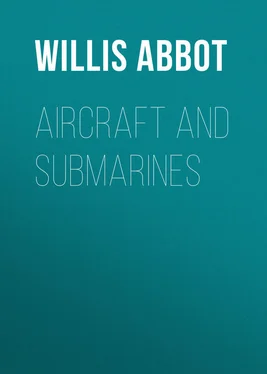Willis Abbot - Aircraft and Submarines
Здесь есть возможность читать онлайн «Willis Abbot - Aircraft and Submarines» — ознакомительный отрывок электронной книги совершенно бесплатно, а после прочтения отрывка купить полную версию. В некоторых случаях можно слушать аудио, скачать через торрент в формате fb2 и присутствует краткое содержание. Жанр: foreign_antique, foreign_prose, на английском языке. Описание произведения, (предисловие) а так же отзывы посетителей доступны на портале библиотеки ЛибКат.
- Название:Aircraft and Submarines
- Автор:
- Жанр:
- Год:неизвестен
- ISBN:нет данных
- Рейтинг книги:4 / 5. Голосов: 1
-
Избранное:Добавить в избранное
- Отзывы:
-
Ваша оценка:
- 80
- 1
- 2
- 3
- 4
- 5
Aircraft and Submarines: краткое содержание, описание и аннотация
Предлагаем к чтению аннотацию, описание, краткое содержание или предисловие (зависит от того, что написал сам автор книги «Aircraft and Submarines»). Если вы не нашли необходимую информацию о книге — напишите в комментариях, мы постараемся отыскать её.
Aircraft and Submarines — читать онлайн ознакомительный отрывок
Ниже представлен текст книги, разбитый по страницам. Система сохранения места последней прочитанной страницы, позволяет с удобством читать онлайн бесплатно книгу «Aircraft and Submarines», без необходимости каждый раз заново искать на чём Вы остановились. Поставьте закладку, и сможете в любой момент перейти на страницу, на которой закончили чтение.
Интервал:
Закладка:
The story that Zeppelin had refused repeated offers from other governments was widely published and evoked patriotic enthusiasm. With it went shrewd hints that in these powerful aircraft lay the way to overcome the hated English navy, and even to carry war to the very soil of England. It was then eight years before the greatest war of history was to break out, but even at that date hatred of England was being sedulously cultivated among the German people by those in authority.
As a result of this national attitude Count Zeppelin's enterprise was speedily put on a sound financial footing. Though "No. IV." had been destroyed by an accident it had been the purpose of the government to buy her, and $125,000 of the purchase price was now put at the disposal of the Count von Zeppelin. A popular Zeppelin fund of $1,500,000 was raised and expended in building great works. Thenceforward there was no lack of money for furthering what had truly become a great national interest.
But the progress of the construction of Zeppelins for the next few years was curiously compounded of success and failure. Fate seemed to have decreed to every Zeppelin triumph a disaster. Each mischance was attributed to exceptional conditions which never could happen again, but either they did occur, or some new but equally effective accident did. Outside of Germany, where the public mind had become set in an almost idolatrous confidence in Zeppelin, the great airships were becoming a jest and a byword notwithstanding their unquestioned accomplishments. Indeed when the record was made up just before the declaration of war in 1914 it was found that of twenty-five Zeppelins thus far constructed only twelve were available. Thirteen had been destroyed by accident – two of them modern naval airships only completed in 1913. The record was not one to inspire confidence.
In 1909, during a voyage in which he made nine hundred miles in thirty-eight hours, the rumour was spread that von Zeppelin would continue it to Berlin. Some joker sent a forged telegram to the Kaiser to that effect signed "Zeppelin." It was expected to be the first appearance of one of the great ships at the capital, and the Emperor hastened to prepare a suitable welcome. A great crowd assembled at the Templehoff Parade Ground. The Berlin Airship Battalion was under orders to assist in the landing. The Kaiser himself was ready to hasten to the spot should the ship be sighted. But she never appeared. If von Zeppelin knew of the exploit which rumour had assigned to him – which is doubtful – he could not have carried it out. His ship collided with a tree – an accident singularly frequent in the Zeppelin records – so disabling it that it could only limp home under half power. A rather curt telegram from his Imperial master is said to have been Count von Zeppelin's first intimation that he had broken an engagement.
However, he kept it two months later, flying to Berlin, a distance of 475 miles. He was greeted with mad enthusiasm and among the crowd to welcome him was Orville Wright the American aviator. It is a curious coincidence that on the day the writer pens these words the New York newspapers contain accounts of Mr. Wright's proffer of his services, and aeronautical facilities, to the President in case an existing diplomatic break with Germany should reach the point of actual war. Mr. Wright accompanied his proffer by an appeal for a tremendous aviation force, "but," said he, "I strongly advise against spending any money whatsoever on dirigible balloons of any sort."
Thereafter the progress of Count von Zeppelin was without interruption for any lack of financial strength. His great works at Friedrichshaven expanded until they were capable of putting out a complete ship in eight weeks. He was building, of course, primarily for war, and never concealed the fact that the enemy he expected to be the target of his bomb throwers was England. What the airships accomplished in this direction, how greatly they were developed, and the strength and weakness of the German air fleet, will be dwelt upon in another chapter.
But, though building primarily for military purposes, Zeppelin did not wholly neglect the possibilities of his ship for non-military service. He built one which made more than thirty trips between Munich and Berlin, carrying passengers who paid a heavy fee for the privilege of enjoying this novel form of travel. The car was fitted up like our most up-to-date Pullmans, with comfortable seats, bright lights, and a kitchen from which excellent meals were served to the passengers. The service was not continued long enough to determine whether it could ever be made commercially profitable, but as an aid to firing the Teutonic heart and an assistance in selling stock it was well worth while. The spectacle of one of these great cars, six hundred or more feet long, floating grandly on even keel and with a steady course above one of the compact little towns of South Germany, was one to thrill the pulses.
But the ill luck which pursued Count von Zeppelin even in what seemed to be his moments of assured success was remorseless. In 1912 he produced the monster L-I , 525 feet long, 50 feet in diameter, of 776,900 cubic feet capacity, and equipped with three sets of motors, giving it a speed of fifty-two miles an hour. This ship was designed for naval use and after several successful cross-country voyages she was ordered to Heligoland, to participate in naval manœuvres with the fleet there stationed. One day, caught by a sudden gust of wind such as are common enough on the North Sea, she proved utterly helpless. Why no man could tell, her commander being drowned, but in the face of the gale she lost all control, was buffeted by the elements at their will, and dropped into the sea where she was a total loss. Fifteen of her twenty-two officers and men were drowned. The accident was the more inexplicable because the craft had been flying steadily overland for nearly twelve months and had covered more miles than any ship of Zeppelin construction. It was reported that her captain had said she was overloaded and that he feared that she would be helpless in a gale. But after the disaster his mouth was stopped by the waters of the North Sea.
This calamity was not permitted long to stand alone. Indeed one of the most curious facts about the Zeppelin record is the regular, periodical recurrence of fatal accidents at almost equal intervals and apparently wholly unaffected by the growing perfection of the airships. While L-I was making her successful cross-country flights, L-II was reaching completion at Friedrichshaven. She was shorter but bulkier than her immediate predecessor and carried engines giving her nine hundred horse power, or four hundred more than L-I. On its first official trip this ship exploded a thousand feet in air, killing twenty-eight officers and men aboard, including all the officials who were conducting the trials. The calamity, as explained on an earlier page, was due to the accumulation of gas in the communicating passage between the three cars.
This new disaster left the faith and loyalty of the German people unshaken. But it did decidedly estrange the scientific world from Count von Zeppelin and all his works. It was pointed out, with truth, that the accident paralleled precisely one which had demolished the Severo Pax airship ten years earlier, and which had caused French inventors to establish a hard and fast rule against incorporating in an airship's design any inclosed space in which waste gas might gather. This rule and its reason were known to Count von Zeppelin and by ignoring both he lent new colour to the charge, already current in scientific circles, that he was loath to profit by the experiences of other inventors.
Whether this feeling spread to the German Government it is impossible to say. Nor it is easy to estimate how much official confidence was shaken by it. The government, even before the war, was singularly reticent about the Zeppelins, their numbers and plans. It is certain that orders were not withheld from the Count. Great numbers of his machines were built, especially after the war was entered upon. But he was not permitted longer to have a monopoly of government aid for manufacturers of dirigibles. Other types sprung up, notably the Schutte-Lanz, the Gross, and the Parseval. But being first in the field the Zeppelin came to give its name to all the dirigibles of German make and many of the famous – or infamous – exploits credited to it during the war may in fact have been performed by one of its rivals.
Читать дальшеИнтервал:
Закладка:
Похожие книги на «Aircraft and Submarines»
Представляем Вашему вниманию похожие книги на «Aircraft and Submarines» списком для выбора. Мы отобрали схожую по названию и смыслу литературу в надежде предоставить читателям больше вариантов отыскать новые, интересные, ещё непрочитанные произведения.
Обсуждение, отзывы о книге «Aircraft and Submarines» и просто собственные мнения читателей. Оставьте ваши комментарии, напишите, что Вы думаете о произведении, его смысле или главных героях. Укажите что конкретно понравилось, а что нет, и почему Вы так считаете.












